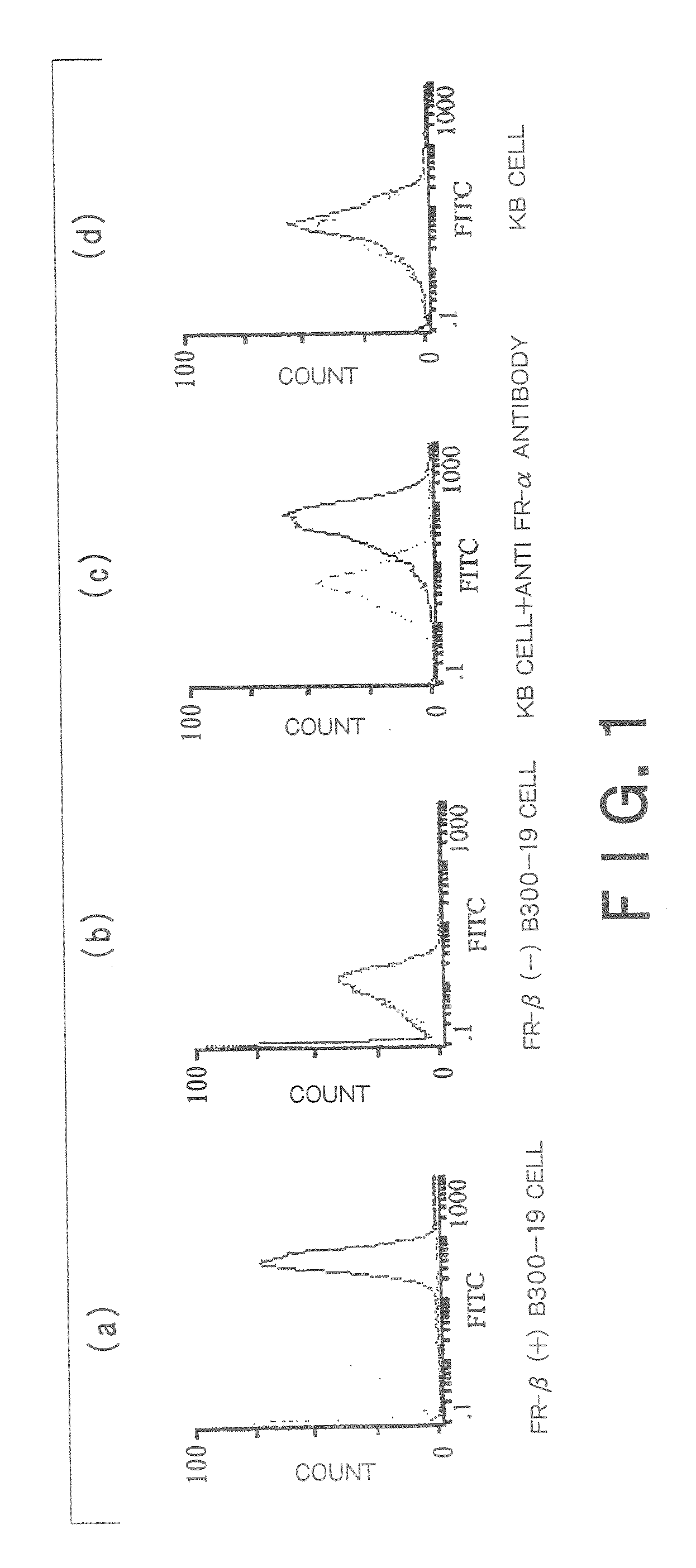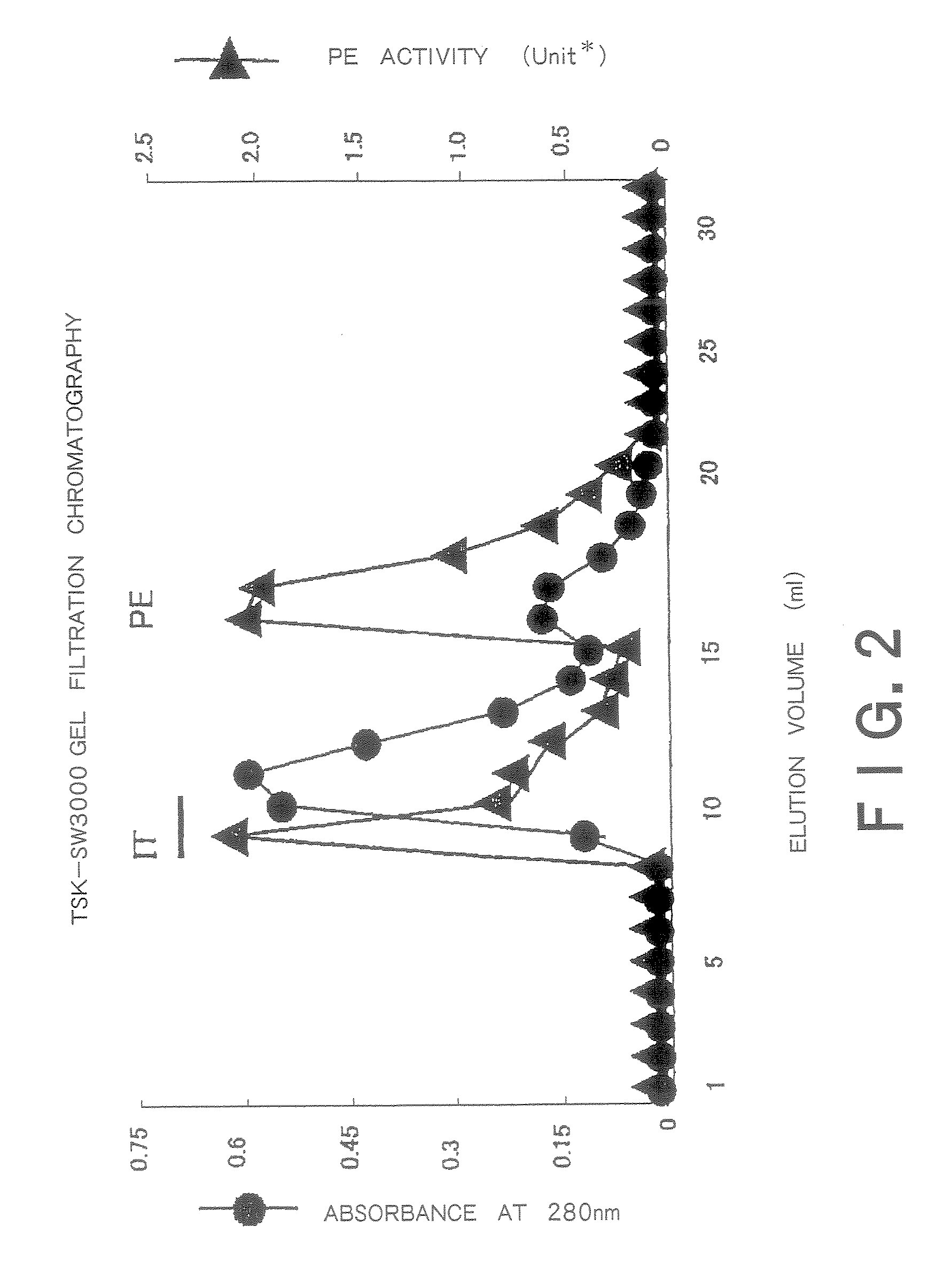Therapeutic Medicine Containing Monoclonal Antibody Against Folate Receptor Beta (Fr-Beta)
a monoclonal antibody and folate receptor technology, applied in the field of therapeutic medicines containing monoclonal antibodies against folate receptor beta (fr-beta), can solve the problem of not reporting on the construction of an igg-type fr- monoclonal antibody, and achieve the effect of increasing isotonicity and chemical stability
- Summary
- Abstract
- Description
- Claims
- Application Information
AI Technical Summary
Benefits of technology
Problems solved by technology
Method used
Image
Examples
example 1
[0239]Whole RNA (200 μg) was extracted from rheumatoid arthritis synovial cells (1×107) with trizole (Gibco B L) according to the manufacturer's instruction. An admixture of 5 μl of the whole RNA (1 μg / μl), 1 μl of 10 mM dNTP (dATP, dGTP, dCTP, and dTTP), and 1 μl of oligo (dT) 12-18 primer (0.5 μg / μl) was reacted at 65° C. for 5 minutes and then allowed to stand in ice for 1 minute.
[0240]Further, 2 μl of 10×RT buffer solution, 24 μl of 25 mM MgCl2, 2 μl of 0.1 M DTT, and 2 μl of RNase OUT™ were added thereto and the resulting admixture was reacted for 2 minutes. Further, 1 μl of transcriptase (Superscript™ reverse transcriptase, Invitrogen) was added thereto and the resulting admixture was reacted at 70° C. for 15 minutes and then allowed to stand in ice for 2 minutes. Further, 1 μl of RNase H was added and the resulting admixture was reacted at 37° C. for 20 minutes to complete cDNA synthesis.
[0241]After obtaining cDNA, PCR was performed using 4.5 μl of the reaction product, 40 μM...
example 2
[0246]A mixture of the FR-β-expressing B300-19 cells (1×107) with Freund's complete adjuvant was immunized into 3 places on the back and the abdominal cavity of Balb / C mice. Further, 2 weeks later a mixture of the B300-19 cells (1×107) with Freund's incomplete adjuvant was immunized into the abdominal cavity of Balb / C mice. This immunization was further repeated 2 to 4 times.
[0247]Monoclonal antibodies were prepared by the method of Kohler and Milstein (Nature (1975); 256:495-96) or its modified method. The spleen (and several large lymph nodes, if necessary) was dissected and dissociated into single cells. All the dissociated spleen cells were fused with myeloma cells and the hybridomas thus constructed were cultured in a HAT selective medium. Hybridomas which reacted with the immunogen in the culture supernatant were selected.
[0248]The hybridomas thus obtained were cultured on plates by the limited dilution method and assayed for production of antibodies which specifically bind to...
example 3
[0250]The hybridoma cells (1×107) were intraperitoneally injected into mice to which 0.5 cc of pristine had been injected 2 weeks earlier into the abdominal cavity and ascites was obtained 2 to 3 weeks later. A 0.5 ml portion of the ascites was loaded onto a protein G column and then the column was washed with a 10-fold volume of phosphate buffer, after which eluate was carried out with 2.5 pH glycine buffer. The pH of the eluate was adjusted to 8.0 with Tris buffer and the eluate was subjected to dialysis with PBS for 24 hours and then concentrated. From 0.5 ml of the ascites, 1 to 2 mg of IgG was obtained.
PUM
| Property | Measurement | Unit |
|---|---|---|
| temperature | aaaaa | aaaaa |
| pH | aaaaa | aaaaa |
| temperature | aaaaa | aaaaa |
Abstract
Description
Claims
Application Information
 Login to View More
Login to View More - R&D
- Intellectual Property
- Life Sciences
- Materials
- Tech Scout
- Unparalleled Data Quality
- Higher Quality Content
- 60% Fewer Hallucinations
Browse by: Latest US Patents, China's latest patents, Technical Efficacy Thesaurus, Application Domain, Technology Topic, Popular Technical Reports.
© 2025 PatSnap. All rights reserved.Legal|Privacy policy|Modern Slavery Act Transparency Statement|Sitemap|About US| Contact US: help@patsnap.com



